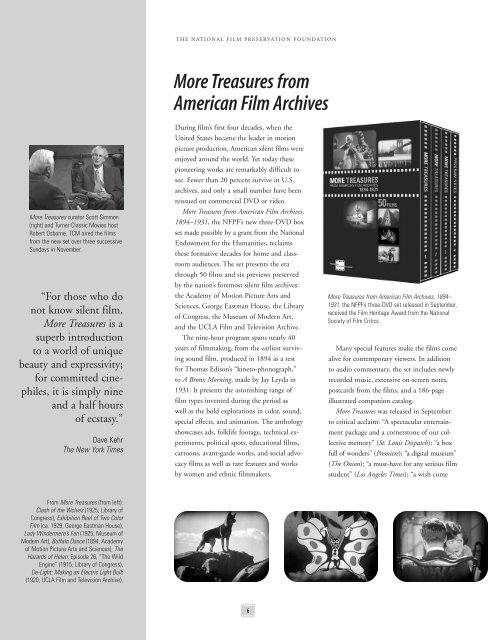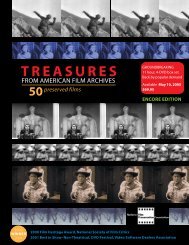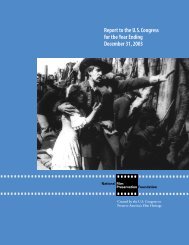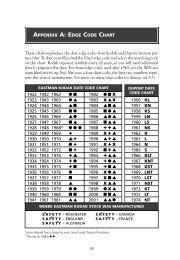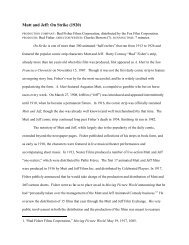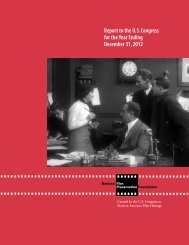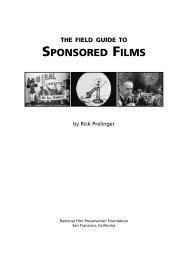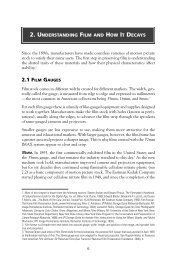view - National Film Preservation Foundation
view - National Film Preservation Foundation
view - National Film Preservation Foundation
You also want an ePaper? Increase the reach of your titles
YUMPU automatically turns print PDFs into web optimized ePapers that Google loves.
THE NATIONAL FILM PRESERVATION FOUNDATION<br />
More Treasures from<br />
American <strong>Film</strong> Archives<br />
More Treasures curator Scott Simmon<br />
(right) and Turner Classic Movies host<br />
Robert Osborne. TCM aired the films<br />
from the new set over three successive<br />
Sundays in November.<br />
“For those who do<br />
not know silent film,<br />
More Treasures is a<br />
superb introduction<br />
to a world of unique<br />
beauty and expressivity;<br />
for committed cinephiles,<br />
it is simply nine<br />
and a half hours<br />
of ecstasy.”<br />
Dave Kehr<br />
The New York Times<br />
During film’s first four decades, when the<br />
United States became the leader in motion<br />
picture production, American silent films were<br />
enjoyed around the world. Yet today these<br />
pioneering works are remarkably difficult to<br />
see. Fewer than 20 percent survive in U.S.<br />
archives, and only a small number have been<br />
reissued on commercial DVD or video.<br />
More Treasures from American <strong>Film</strong> Archives,<br />
1894–1931, the NFPF’s new three-DVD box<br />
set made possible by a grant from the <strong>National</strong><br />
Endowment for the Humanities, reclaims<br />
these formative decades for home and classroom<br />
audiences. The set presents the era<br />
through 50 films and six pre<strong>view</strong>s preserved<br />
by the nation’s foremost silent film archives:<br />
the Academy of Motion Picture Arts and<br />
Sciences, George Eastman House, the Library<br />
of Congress, the Museum of Modern Art,<br />
and the UCLA <strong>Film</strong> and Television Archive.<br />
The nine-hour program spans nearly 40<br />
years of filmmaking, from the earliest surviving<br />
sound film, produced in 1894 as a test<br />
for Thomas Edison’s “kineto-phonograph,”<br />
to A Bronx Morning, made by Jay Leyda in<br />
1931. It presents the astonishing range of<br />
film types invented during the period as<br />
well as the bold explorations in color, sound,<br />
special effects, and animation. The anthology<br />
showcases ads, folklife footage, technical experiments,<br />
political spots, educational films,<br />
cartoons, avant-garde works, and social advocacy<br />
films as well as rare features and works<br />
by women and ethnic filmmakers.<br />
More Treasures from American <strong>Film</strong> Archives, 1894–<br />
1931, the NFPF’s three-DVD set released in September,<br />
received the <strong>Film</strong> Heritage Award from the <strong>National</strong><br />
Society of <strong>Film</strong> Critics.<br />
Many special features make the films come<br />
alive for contemporary <strong>view</strong>ers. In addition<br />
to audio commentary, the set includes newly<br />
recorded music, extensive on-screen notes,<br />
postcards from the films, and a 186-page<br />
illustrated companion catalog.<br />
More Treasures was released in September<br />
to critical acclaim: “A spectacular entertainment<br />
package and a cornerstone of our collective<br />
memory” (St. Louis Dispatch); “a box<br />
full of wonders” (Premiere); “a digital museum”<br />
(The Onion); “a must-have for any serious film<br />
student” (Los Angeles Times); “a wish come<br />
From More Treasures (from left):<br />
Clash of the Wolves (1925, Library of<br />
Congress), Exhibition Reel of Two Color<br />
<strong>Film</strong> (ca. 1929, George Eastman House),<br />
Lady Windermere’s Fan (1925, Museum of<br />
Modern Art), Buffalo Dance (1894, Academy<br />
of Motion Picture Arts and Sciences), The<br />
Hazards of Helen: Episode 26, “The Wild<br />
Engine” (1915, Library of Congress),<br />
De-Light: Making an Electric Light Bulb<br />
(1920, UCLA <strong>Film</strong> and Television Archive).<br />
6


